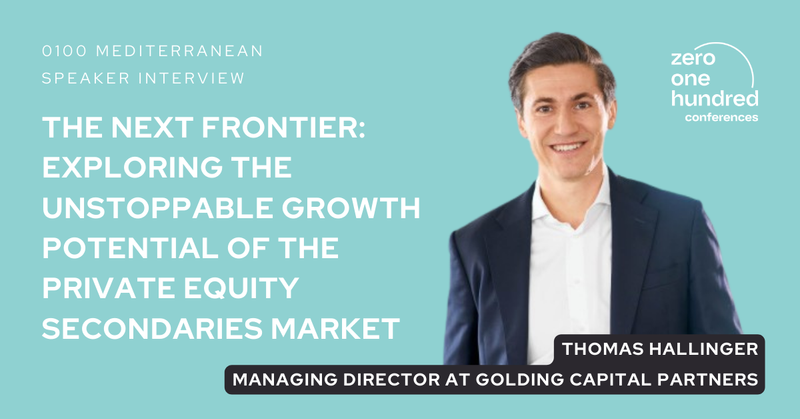In this Speaker Interview, we sat down with Thomas Hallinger, Managing Director (Secondaries) at Golding Capital Partners, a leading independent asset manager specializing in alternative investments with €14.5bn in assets under management.
Thomas will be speaking at the 0100 Conference Mediterranean in Milan at the panel “The Rise of the Secondaries Market in the Mediterranean Countries” with key industry players: Ricardo Miró-Quesada, Partner & Head of PE at Arcano, Alberto Chalon, Founding Partner at Giano Capital, Miguel Echenique, Partner at AltamarCAM, Giuliano Gregori, Executive Director of Private market secondaries at Morgan Stanley, and moderated by Eriprando Guerritore, Shareholder at Greenberg Traurig.
Learn more about Golding Capital Partners’ unique private equity secondary strategy, the growing market opportunities in Mediterranean countries, and the factors contributing to the rise of the secondaries market globally: from identifying the right assets to discussing the future growth of secondaries.

What is Golding Capital Partners’ private equity secondary strategy?
Golding Capital Partners is an independent asset manager for alternative investments, managing around €14.5bn AuM across private equity, private credit, infrastructure equity, and impact investments on behalf of a trusted group of more than 230 international institutional investors. We are active across primaries, secondaries, and co-investments.
As for our private equity secondary strategy, we are focused on the smaller end of the market, investing in both select LP- and GP-led transaction opportunities in Europe and North America. High-quality and fast-growing trophy assets are a natural fit for us and a segment where we can leverage the Golding platform and the relationships we have built with sponsors over the past 20+ years. The fact that we have never lost a Euro on any of our secondary transactions and distribute cash early is a direct result of our careful due diligence approach, disciplined investment strategy, and policy to avoid applying additional leverage to finance transactions.
We are currently in the final stages of raising our sophomore fund, which has a €500 million target and is already more than 50% deployed. The fund has already generated significant value for investors, with a few realizations enabling us to return cash to investors soon after the fund’s final close.
What are the main challenges in identifying the right assets or deals for secondaries transactions compared to other alternative investments?
Private equity secondaries come with a unique set of opportunities and challenges due to the distinct nature of the secondary market.
An exemplary, non-exhaustive list of these challenges includes topics such as transparency and access to information, intricacies around valuation, timing and liquidity considerations, legal and structuring complexities, the ability to influence and control, asymmetric information, market dynamics and competition on deals, as well as a number of ‘special’ items depending on the type of secondary transaction opportunity. For example, concentration risks or alignment with management and the private equity manager in a GP-led transaction.
Being mindful of the above, limited partners are clearly advised to back the ‘right’ and experienced secondary platform to invest alongside and to take advantage of the vast opportunities present in today’s market … which, in my opinion, undoubtedly outweigh the aforementioned and controllable challenges.
What factors have contributed to the rise of the secondaries market in Mediterranean countries?
I think the most obvious answer is that there are a myriad of benefits to investing in Mediterranean countries. While each of the countries in the Mediterranean we focus on offers its own set of attractions, they all share important characteristics such as robust economic growth, diverse industries – for example, Italy is home to a fantastic set of high-quality, niche-leading assets across numerous industries ranging from industrial technology/ manufacturing, professional services to iconic brands and products – as well as great talent and the necessary stable environment and legal regime (following reforms in recent years) for an investment. And guess what Italy, Spain, and France all have in common besides great cuisine and wine? They are all projected to see higher GDP growth in 2024 compared to Germany.
In addition, there are also a few specific factors which have facilitated the evolution and further ‘adoption’ of secondaries as a viable solution in the Mediterranean. An example would be the growth in and increasing maturity of private equity in the region. Firms have raised larger funds with more capital to be deployed in recent years, new local buyout managers have emerged and more and more international managers have set-up local teams and made the Mediterranean ‘in-scope’ for their investment strategies. As a result, we are seeing both more – in absolute Euro-terms – and ageing NAV waiting to be realized within portfolios today, while institutional investors in the region are facing the same hunger for liquidity as in other geographies … a mounting and lasting problem that the secondary market will gladly (continue to) take advantage of.
How does the secondaries market in the Mediterranean region compare to the rest of Europe, and how does Europe as a whole compare to the U.S.?
Volume-wise, reliable market figures from reputable secondary market advisors have historically oscillated around two-thirds in North America and one-quarter in Europe (higher share for GP-led transactions), with the remaining volume being shared by APAC and RoW. There are no precise numbers for the Mediterranean countries available, but it is fair to highlight that these countries – with France being the exception – tend to show less private equity deal activity in general than, for example, the UK, DACH, the Nordics, or Benelux.
However, as an active investor in the Mediterranean for the past two decades across our strategies, I can certainly confirm that the Mediterranean is catching up quickly, particularly in secondaries and we have seen multiple attractive opportunities in the past twelve months, some of which we ended up investing in. Judging by the fruitful conversations we are having with managers about potential GP-led transactions, discussions with institutional investors about their desire for liquidity, and conversations with advisors building their pipeline, I am certain that this trend will continue.
Given the increasing need for liquidity, exits, and M&As, how much growth potential do you see in the secondaries market over the next five years? Is this just the beginning?
Quite simple: I am convinced that current favorable dynamics and growth in the secondary market will prevail, and we are going to see more of the same, albeit higher, faster and more nuanced. Reaching the next frontier, $200 billion of transacted global secondary volume, is less a question of if, but when (particularly) the large secondary firms are able to raise their multi-billion Euro funds that are necessary for us as a market to, ultimately be able to digest and transact those higher volumes.
The most exciting part in my opinion? With more and more buyers moving up in size and focusing on bigger transactions of larger exposures to deploy the vast amounts raised, we will be seeing even less competition in our segment of smaller transactions. This really is just the beginning and we are super excited about the prospects of continuing to invest in high-quality and growing companies at attractive prices and alongside the very best sponsors out there.

